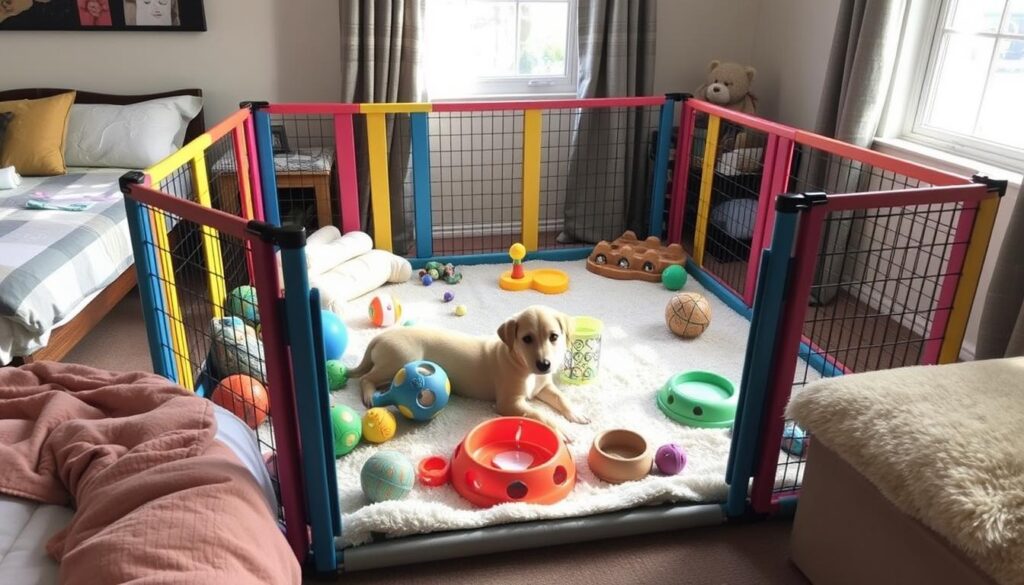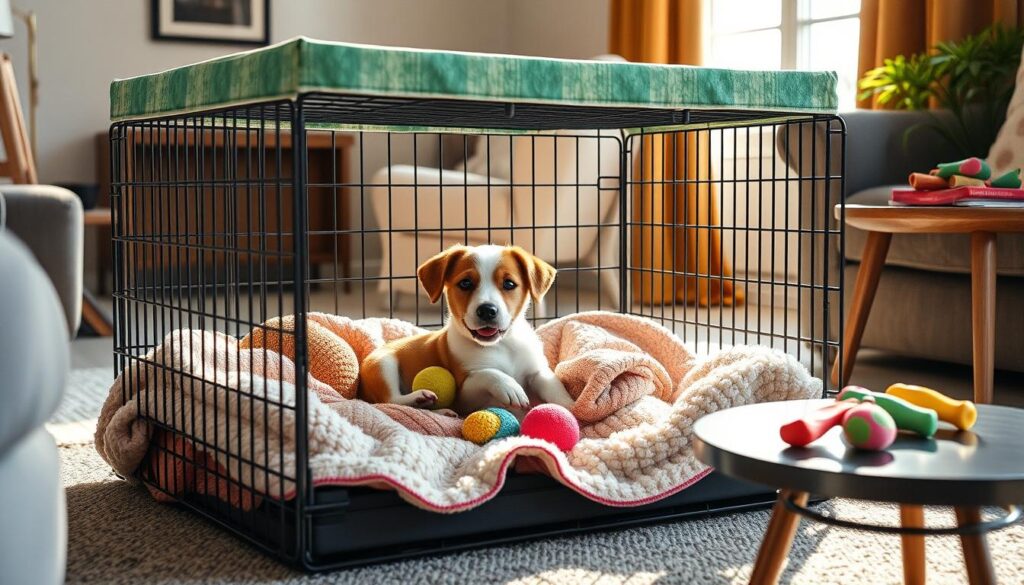How To Crate Train While Working From Home

Imagine you’re in a Zoom call, talking about work, and your puppy suddenly runs into your office. It’s a mess! This is what happens when you try to crate train a puppy while working from. It’s a mix of work and puppy love. It might seems hard to pull of at first, but if I managed, you will too.
Finding a balance is key. You need a routine that works for your puppy and your work and in this guide will show you how to crate train your puppy even while working from home. It will help keep your puppy and your work safe.
Key Takeaways
- Crate training helps create a safe space for puppies during work hours
- Establishing a consistent routine is crucial for successful crate training
- Gradual introduction to the crate prevents anxiety and promotes positive associations
- Regular breaks allow for potty time and bonding with your puppy
- Proper crate size and comfort are essential for effective training
- Positive reinforcement techniques encourage puppies to enjoy their crate time
- Balancing work and puppy care leads to a well-adjusted dog and productive home office
Setting Up for Success
Getting your puppy ready for crate training at home needs some planning. The right setup will make or brake your success.
Choosing the Right Crate
Finding the perfect crate is important. You have to make sure it’s big enough for your dog to move around and sleep. Not just while being a puppy, but also when he grows. Wire crates are great because they have good airflow and are flexible. You can find good used crates for less than $50 on Amazon.
Creating a Comfortable Crate Environment
Puppies want to be comfy, just like me and you. Make the crate a cozy spot by covering it with a puppy or baby blanket. Add soft bedding and toys your dog loves and trust me, this will make your dog feel safe while you work.
I have some pillows and a heated blanket in there. Really helped in the colder months.
Features to Look for in a Quality Crate
When looking for a crate, focus on these important features:
- Sturdy construction for safety
- Proper ventilation to keep your dog cool
- Easy-to-clean materials for maintenance
- Secure latches to prevent escapes
| Crate Type | Pros | Cons |
|---|---|---|
| Wire Crate | Good airflow, collapsible | Less den-like feel |
| Plastic Crate | More private, travel-friendly | Less ventilation |
| Soft-sided Crate | Lightweight, portable | Less durable, not chew-proof |
Gradual Introduction to the Crate

Integrating Crate Time into Your Daily Schedule
Your work-from-home schedule should include crate time for your puppy. Start by putting your dog near the crate 20-30 minutes before work. This helps them noticing the crate and it won’t be such a big scary thing for them.
You can read our article ”How To Introduce a Puppy to a Crate” for more information about this topic.
Using Breaks Effectively
Plan puppy breaks every 45-60 minutes during work. Use these times for potty trips, play, and training. Short breaks keep your puppy happy and prevent accidents. A regular schedule teaches your puppy when to expect attention and when to rest.
| Time | Activity | Duration |
|---|---|---|
| 8:30 AM | Morning walk and breakfast | 30 minutes |
| 9:00 AM | Crate time (work starts) | 45 minutes |
| 9:45 AM | Puppy break (potty and play) | 15 minutes |
| 10:00 AM | Crate time (resume work) | 45 minutes |
| 10:45 AM | Puppy break (training session) | 15 minutes |
By following this structured plan, you’ll have a balanced work-from-home schedule. It meets your work needs and your puppy’s needs. Remember, being consistent is key in crate training.
Introducing your dog to a crate is a big step in training. It’s important to make the crate a positive place. This means training slowly and being patient, especially if you work from home.
Initial Exploration During Work Hours
Begin by leaving the crate door open while you work. Put treats inside to draw your dog in. This lets them explore at their own speed, making them feel safe and curious.
Short Confinement Sessions
When your dog is comfortable going into the crate, start short sessions. Begin with a few minutes and then add more time. Remember, puppies under 6 months should not be crated for more than 3-4 hours.
| Age | Maximum Crate Time | Recommended Breaks |
|---|---|---|
| 8-10 weeks | 30-60 minutes | Every 1-2 hours |
| 11-14 weeks | 1-3 hours | Every 2-3 hours |
| 15-16 weeks | 3-4 hours | Every 3-4 hours |
| 17+ weeks | 4-5 hours | Every 4-5 hours |
Remember, crate training can take days or weeks. Be patient and keep training up. The goal is to make the crate a safe, cozy space for your dog. With time and positive rewards, your dog will see the crate as their own special place.
Managing Distractions While Working

To stay focused, create a good space for both you and your puppy. Here are some tips to help you work better and keep your puppy happy.
Minimizing Noise and Interruptions
Put your puppy’s crate away from your desk. This helps you work without interruptions. When on calls, mute your mic if your puppy barks a lot. Tell your colleagues about your puppy to avoid surprises.
Monitoring Behavior
Watch your puppy all day. Use fun toys and treats during calls to keep them busy. Puzzle toys are great for their mind and keep them occupied while you work.
Having a routine is important as it helps you manage your puppy and work well. Here’s a simple schedule for both:
| Time | Activity |
|---|---|
| 7:30 AM | Wake up |
| 7:35 AM | 20-minute dog walk |
| 8:00 AM | Coffee for owner, breakfast for pup |
| 11:30 AM | Check emails and messages |
| 1:00 PM | Conference calls and work |
| 3:30 PM | Playtime and training |
| 5:00 PM | Dinner for pup |
| 6:00 PM | Yoga or workout |
| 8:30 PM | Final walk |
| 10:00 PM | Bedtime |
Stick to a schedule and use these tips. You can manage distractions, keep your puppy happy, and work better. Plus, you get to enjoy your furry friend’s company.
Addressing Separation Anxiety

Separation anxiety in dogs is tough for pet owners who work from home. About 14% of dogs really have separation anxiety. Many more feel anxious when confined. To help your dog, give them interactive toys and teach crate training.
Providing Interactive Toys
Interactive dog toys are key to keeping your pup happy and calm. Here are some good ones:
- Puzzle feeders
- Treat-dispensing balls
- Chew toys
- Lick mats
These toys can stop confinement anxiety and keep your dog busy. Studies show dogs with these toys are 30% less anxious.
Incorporating Training into Breaks
Use your breaks to teach good habits and bond with your dog. Try these crate training tips:
- Practice the “go to your crate” command
- Reward calm behavior in the crate
- Gradually increase crate time
- Teach a solid “place” command
Regular training can make your dog 70% less anxious. Be patient – it might take weeks to see big changes.
| Training Method | Success Rate | Average Time to See Results |
|---|---|---|
| Reward-based training | 85% | 4-6 weeks |
| Gradual crate time increase | 78% | 3-5 weeks |
| Interactive toy use | 72% | 2-4 weeks |
Keeping Puppies Engaged While Crated

Puppy enrichment is really important when crate training your furry friend. Keeping your puppy engaged while crated helps prevent boredom and reduces stress. Let’s look at some crate alternatives that can make your puppy’s time more enjoyable.
Benefits and Limitations of X-Pens
X-pens offer a spacious alternative to traditional crates. These versatile enclosures provide more room for your puppy to move and play. X-pens allow your pup to see you while you work, reducing separation anxiety. They’re great for younger puppies who need more space to explore.
Despite their advantages, X-pens have limitations. They may not be suitable for larger or more active dogs due to potential instability. Some puppies might find it easier to escape from X-pens compared to crates.
Comparing X-Pens to Traditional Crates
When choosing between X-pens and crates, consider your puppy’s needs and your living situation. Here’s a comparison to help you decide:
| Feature | X-Pens | Traditional Crates |
|---|---|---|
| Space | More spacious | Confined area |
| Visibility | Open design | Limited visibility |
| Security | Less secure for escape artists | More secure containment |
| Portability | Bulkier to move | Easy to transport |
| Puppy Enrichment | Room for toys and activities | Limited space for enrichment |
Remember, both X-pens and crates can be effective tools for puppy training. Your choice depends on your puppy’s personality, size, and your home setup. Whichever option you choose, ensure it provides a safe, comfortable space for your furry friend.
Ensuring Long-Term Success with Crate Training
Long-term crate training needs patience and consistency. As your puppy grows, keep crate time positive. This makes the crate a safe, comfy space for your dog.
Maintaining Positive Associations
Always make sure that crate time in fun time. A dog, me and surely you too, will never do something that hurts or scares us. If you use your crate as punishment, you are bound to fail long term success. LEt them play in the crate, let your dog sleep or eat in the crate. All the moments will make sure your puppy will love the crate.
I always fed my dog in his crate. I always cuddled with him in his crate. Now, he sleeps in his crate almost 24/7.
Signs Your Dog is Ready for More Freedom
Look for signs your dog is ready for more space:
- Staying calm in the crate for longer
- No accidents in the house
- Good response to commands
Gradual Expansion of Living Space
Begin with 1-2 hours of free time for small dogs, 2-3 hours for big ones. Increase this over two weeks. By 6-7 months, dogs can safely have more freedom.
Remember, earning freedom is key. Always keep your pet’s safety first. With patience and training, your dog will enjoy more freedom.
Conclusion
Training your puppy to use a crate while you work from home takes time and effort. Make the crate a cozy spot and fit it into your daily life. This way, you can balance work and taking care of your puppy safely. Start crate training early, but it might take up to six months for your puppy to get used to it.
Puppies under six months shouldn’t be in a crate for more than four to five hours. Start by introducing the crate slowly. Use treats to make it a positive experience and never push your puppy into it. This helps with housebreaking and keeps your puppy safe during trips and emergencies.
Remember, crate training is not just about keeping your puppy in a small space. It helps build trust and confidence. It also keeps your dog safe. With patience and the right steps, you and your puppy can live happily together, even when you’re working from home.


